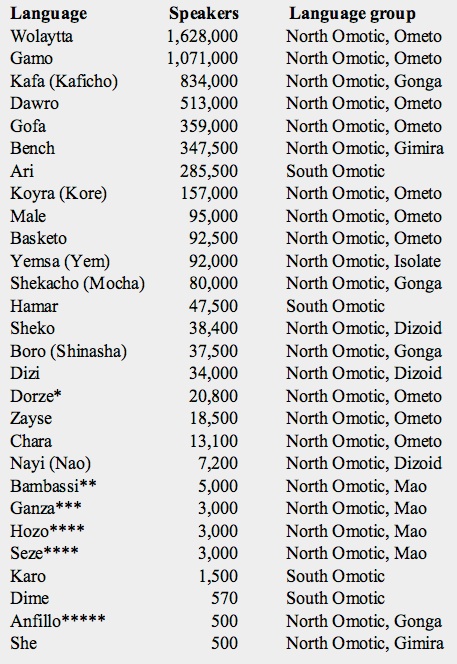An insatiable appetite for ancient and modern tongues


Overview and Distribution. Omotic are a group of close to 30 languages, spoken by about six million people, in the south west of Ethiopia around the river Omo (hence their name). They constitute, according to many scholars, one of the six branches of the Afro-Asiatic phylum. However, they are little studied and the Afro-Asiatic membership of Omotic is controversial being regarded by some as an independent family. Omotic have affinities with Cushitic, another branch of Afro-Asiatic.
Internal Classification. The 28 Omotic languages are divided into northern and southern sub-families. North Omotic includes 24 languages in several groups.
-
North Omotic (24).
-
Gonga group: Kafa or Kaficho, Shekacho or Mocha, Boro or Shinasha, Anfillo.
-
Dizoid group: Dizi, Sheko, Nayi or Nao.
-
Gimira group: Bench, She.
-
Ometo group: Wolaytta, Dorze, Gamo, Gofa, Dawro, Basketo, Male, Zayse, Koyra or Kore, Chara.
-
Mao group: Bambassi, Ganza, Hozo, Seze.
-
Isolate: Yemsa or Yem.
-
The position of the Mao group within Omotic is unclear; many consider it a third, separate, sub-family.
-
South Omotic (4).
-
Hamar, Dime, Ari, Karo.

The Ometo and Gonga groups are the most numerous (four million and one million speakers, respectively). The other groups have, in total, 1 million or less.
*data from 1994 census
** data from 1982 (SIL)
*** spoken in Sudan-Ethiopia border
**** data from 1995 (SIL)
***** data from 1990 (SIL)
SHARED FEATURES
-
✦ Phonology
-
-Most Omotic languages have short words, many of them monosyllabic.
-
-Vowel systems are composed of five short and five long vowels. Vowel length is phonemic.
-
-They have glottalized stops including implosives and ejectives (sometimes in the same language). They lack pharyngeal consonants.
-
-They are distinguished by the lack of the consonant p, a feature shared by many Afro-Asiatic languages.
-
-Tonal accents, rather than true tones, are employed to make lexical distinctions, a necessity due to the abundance of monosyllabic words. Sheko has 3, Yemsa 3 and Bench has a system of six tones, which makes it unique within Africa.
-
✦ Morphology
-
Nominal
-
-There is no grammatical gender, the main distinction is between animate and inanimate. In animate nouns, gender is determined by sex. Inanimate nouns are inflected like masculine nouns. Only definite nouns are marked for plural, the singular is unmarked.
-
-Omotic distinguishes subject and object by case suffixes as well as by tonal inflection. In some languages the subject case is marked (nominative) while the object remains unmarked (i. e., identical to the quotation form of the noun). In other languages the object is marked (accusative) while the subject is unmarked. The Ometo group shows a predominance of marked-nominative languages, whereas other North Omotic languages and the South Omotic ones have, mostly, accusative systems.
-
Verbal
-
-Most verbs have biconsonantal roots.
-
-Suffixes are added to them to indicate tense/aspect, followed by others for person/number.
-
✦ Syntax
-
-Omotic languages are head-final. Word order is Subject-Object-Verb in all of them. Nominal modifiers are followed by noun and main verb, which is always final. Postpositions are used.
Scripts
Omotic languages are seldom written but when they are, the Ge'ez (Ethiopic) or Latin alphabets are used.
-
© 2013 Alejandro Gutman and Beatriz Avanzati
Further Reading
-
-The Non-Semitic Languages of Ethiopia. M. L. Bender (ed). Michigan State University (1976).
-
-Omotic: A New Afroasiatic Language Family. M. L. Bender. Southern Illinois University (1975).
-
-Omotic Language Studies. R. J. Hayward (ed). Routledge (1990).
-
-The 2007 Population and Housing Census of Ethiopia. Central Statistical Agency of Ethiopia.
Omotic Languages

Address comments and questions to: gutman37@yahoo.com
MAIN LANGUAGE FAMILIES
LANGUAGE AREAS
Languages of Ethiopia & Eritrea
LANGUAGES by COUNTRY
LANGUAGE MAPS
-
• America
-
• Asia
-
Countries & Regions
-
-
Families
-
• Europe
-
• Oceania